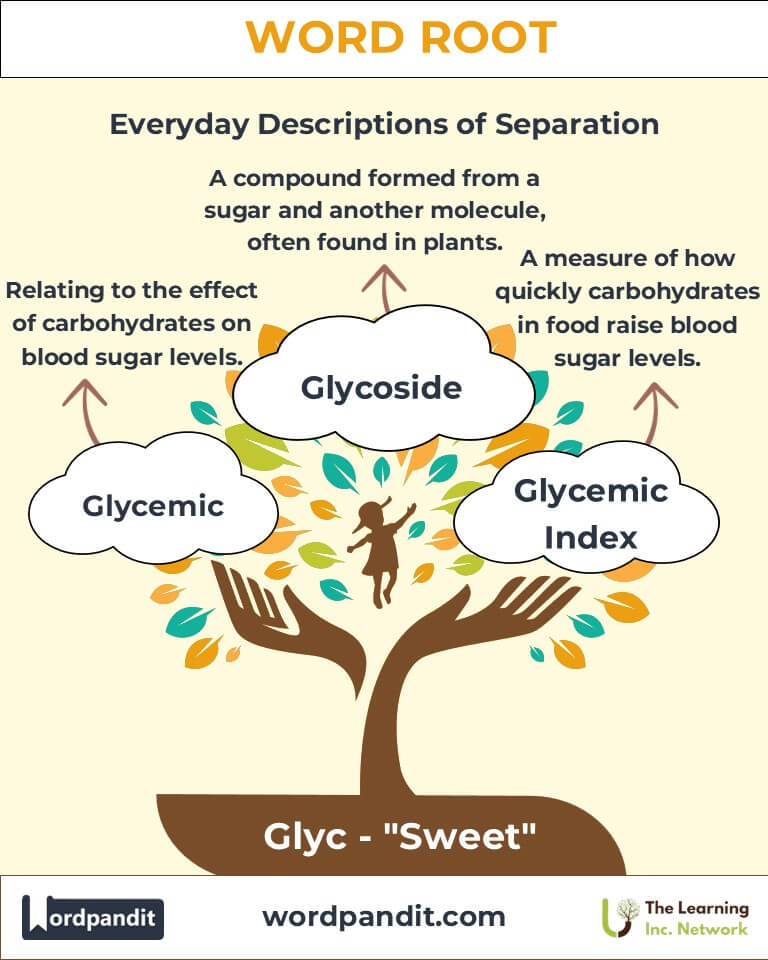Glyc: The Sweet Root in Science and Language
Uncover the fascinating world of the word root glyc, derived from the Greek word "glukus," meaning sweet. From biology to chemistry, this root weaves sweetness into terms like glycerin, a key ingredient in moisturizers, and glycogen, the body’s sugar storage molecule. Explore the versatility of glyc across disciplines and discover its sweet legacy in science, medicine, and culture.

Table of Contents
- Introduction: The Sweet Essence of Glyc
- Etymology and Historical Journey
- Mnemonic: Unlocking the Power of Glyc
- Common Glyc-Related Terms
- Glyc Through Time
- Glyc in Specialized Fields
- Illustrative Story: Glyc in Action
- Cultural Significance of Glyc
- The Glyc Family Tree
- FAQs about the Glyc Word Root
- Test Your Knowledge: Glyc Mastery Quiz
- Conclusion: The Sweet Legacy of Glyc
Introduction: The Sweet Essence of Glyc
When you hear the word sweet, what comes to mind? Perhaps a sugary treat or a kind gesture. The root glyc embodies both the literal and metaphorical meanings of sweetness. Derived from the Greek word glukus (pronounced gloo-kus), it has become a cornerstone of scientific vocabulary, especially in biology and chemistry. From fueling our cells with glycogen to hydrating our skin with glycerin, glyc connects sweetness to essential life processes.

Etymology and Historical Journey
The root glyc traces back to ancient Greece, where glukus described anything sweet in taste. Over centuries, as science and medicine evolved, the root found its way into Latin and later English, shaping terms like glycerin and glucose. The 19th-century rise of organic chemistry saw the root's integration into a growing lexicon, symbolizing the sweetness inherent in carbohydrates and related compounds.
Mnemonic: Unlocking the Power of Glyc
To remember glyc, picture a jar of glycerin labeled "Sweet Essence." Imagine it dripping onto a sugar cube that transforms into a glowing energy molecule, symbolizing the sweetness and energy stored in glycogen.
Mnemonic Device: “Glyc is the root of sweetness, energizing our lives through glucose and glycogen!”
Common Glyc-Related Terms
- Glycerin (GLIH-suh-rin)
- Definition: A sweet-tasting, colorless liquid used in cosmetics and medicine.
- Example: "The glycerin in the lotion keeps my skin soft and hydrated."
- Glycogen (GLY-koh-jen)
- Definition: A carbohydrate stored in the liver and muscles, serving as a key energy source.
- Example: "After intense exercise, glycogen stores in the muscles need replenishment."
- Glucose (GLOO-kohs)
- Definition: A simple sugar and primary energy source for cells.
- Example: "Diabetics monitor their blood glucose levels carefully."
- Glycemic (gly-SEE-mik)
- Definition: Relating to the effect of carbohydrates on blood sugar levels.
- Example: "Foods with a low glycemic index are beneficial for steady energy."
- Glycoside (GLY-koh-side)
- Definition: A compound formed from a sugar and another molecule, often found in plants.
- Example: "Certain glycosides are used in medicines for heart conditions."
Glyc Through Time
- Glukus (Ancient Greek): Originally meant "sweet," but later inspired the naming of key carbohydrates.
- Glycerin (19th Century): Discovered as a byproduct of soap-making, it became a staple in pharmaceuticals.
- Glycemic (Modern): Developed with the rise of nutritional science to measure carbohydrate effects on blood sugar.
Glyc in Specialized Fields
- Biochemistry:
- Glycogen: Vital for energy storage and metabolic regulation.
- Application: Studying glycogen storage diseases sheds light on metabolic disorders.
- Medicine:
- Glycemic Index: A tool for managing diabetes and improving dietary habits.
- Impact: Guides patients toward healthier carbohydrate choices.
- Cosmetics:
- Glycerin: A humectant that locks moisture in the skin.
- Significance: Revolutionized skincare by preventing dryness.
- Botany:
- Glycosides: Found in plants, some glycosides serve as natural defense mechanisms.
- Example: Digitalis glycosides are used in heart medications.
Illustrative Story: Glyc in Action
Dr. Sarah, a nutritionist, helps her patient John manage type 2 diabetes. She explains how foods with a low glycemic index prevent glucose spikes. Meanwhile, her research on glycogen metabolism reveals how exercise impacts energy storage. Inspired, John adopts a balanced diet and regular activity, transforming his health journey. The sweet success of glyc shines in their shared victory!
Cultural Significance of Glyc
Sweetness, symbolized by glyc, carries profound cultural meanings. From ancient rituals using honey as a sacred sweetener to modern celebrations with sugary treats, sweetness is a universal symbol of joy and prosperity. The scientific significance of glyc complements its cultural resonance, bridging the worlds of tradition and innovation.

The Glyc Family Tree
Explore related roots and affixes:
- Sacchar- (Greek: sugar)
- Example: Saccharine - Excessively sweet.
- Example: Saccharide - A sugar molecule.
- Gluc- (Greek: sweet)
- Example: Glucagon - A hormone that raises blood sugar.
- Example: Glucose - A simple sugar vital for energy.
- Suc- (Latin: sugar)
- Example: Sucrose - Common table sugar.
- Example: Sucralose - A calorie-free sweetener.
FAQs About the "Glyc" Word Root
1. What does "glyc" mean, and where does it come from?
The root "glyc" means "sweet" and is derived from the Greek word "glukus." Over centuries, this root became foundational in scientific terms related to sugars, sweetness, and energy storage.
2. What is glycerin, and why is it important?
Glycerin is a sweet, colorless liquid commonly used in cosmetics, medicine, and food products. It acts as a humectant, meaning it attracts and retains moisture, making it vital for skin hydration, preventing dryness, and extending product shelf life.
3. What is the role of glycogen in the body?
Glycogen is the primary storage form of glucose in animals. It is stored in the liver and muscles and is broken down when the body needs energy, especially during physical activity or fasting.
4. How does the glycemic index help in managing health?
The glycemic index measures how quickly carbohydrates in food raise blood sugar levels. Foods with a high glycemic index (e.g., white bread) cause rapid spikes, while those with a low index (e.g., lentils) provide steady energy, making it a useful tool for managing diabetes and maintaining stable energy levels.
5. What are glycosides, and what makes them significant?
Glycosides are compounds where a sugar is chemically bonded to another molecule, often found in plants. They play key roles in medicine, such as in heart treatments (e.g., digitalis glycosides) or as natural defense mechanisms in plants.
6. What’s the difference between glucose and glycogen?
Glucose is a simple sugar and the main energy source for the body’s cells, while glycogen is a complex carbohydrate that stores glucose in the liver and muscles for later use.
7. How is "glyc" relevant to diabetes management?
Terms like glycemic index and glucose monitoring are rooted in "glyc." Managing blood glucose levels through diet, exercise, and medication helps prevent complications like nerve damage or heart disease.
8. What foods replenish glycogen stores?
Foods rich in carbohydrates, such as fruits, pasta, and whole grains, help replenish glycogen stores after intense physical activity. Proper refueling is crucial for athletes and active individuals.
9. How does "glyc" appear in cosmetics?
In cosmetics, "glyc" appears in products like glycerin, which keeps skin hydrated and soft. It’s a key ingredient in moisturizers, serums, and cleansers due to its ability to attract water.
10. What is the significance of "glyc" in plant biology?
In plant biology, glycosides are essential for various plant functions and defense mechanisms. For example, some glycosides deter herbivores, while others store energy or facilitate plant growth.
Test Your Knowledge: Glyc Mastery Quiz
1. What does glyc mean?
2. Which term refers to stored sugar in muscles?
3. What measures blood sugar response?
4. Which term describes a sweet liquid used in cosmetics?
5. What does a glycoside combine?
Conclusion: The Sweet Legacy of Glyc
The root glyc is more than a linguistic fragment—it’s a gateway to understanding sweetness in biology, chemistry, and culture. From the glucose fueling our cells to the glycerin moisturizing our skin, its versatility and importance endure. As science advances, glyc continues to sweeten our knowledge and enrich our lives.












